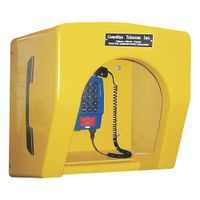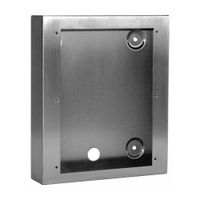Call +(254) 703 030 000 / 751 483 999 / 721 704 777
- Home
- Electronics Batteries
- Electronic Communication Equipment
- Audio Equipment
- Phones Accessories
.....Read More
Frequently Asked Questions
What are the best phones for use in hotels and hospitality settings?
1. **Cisco 8800 Series**: Known for its reliability and advanced features, this series offers high-definition voice, video capabilities, and Bluetooth connectivity, making it ideal for business and hospitality environments.
2. **Avaya J100 Series**: These phones provide excellent audio quality, customizable options, and integration with hotel management systems, ensuring seamless communication for staff and guests.
3. **Yealink T5 Series**: With features like HD voice, touchscreen interfaces, and video conferencing capabilities, these phones are suitable for front desk and conference room settings in hotels.
4. **Mitel 6900 Series**: Offering a range of models with features like Bluetooth, USB ports, and high-quality audio, these phones are designed for flexibility and ease of use in hospitality environments.
5. **Polycom VVX Series**: Known for their superior audio quality and user-friendly interface, these phones are ideal for guest rooms and administrative offices in hotels.
6. **NEC DT800 Series**: These phones offer a range of features including programmable keys, high-quality audio, and integration with hotel management systems, making them suitable for various hospitality settings.
7. **Grandstream GXP Series**: With features like HD audio, multiple line support, and customizable options, these phones are versatile and cost-effective for hotel use.
8. **VTech Hotel Phones**: Specifically designed for the hospitality industry, these phones offer features like customizable faceplates, cordless options, and easy integration with hotel systems.
9. **Alcatel-Lucent 8000 Series**: These phones provide excellent audio quality, intuitive interfaces, and integration capabilities, making them suitable for both guest rooms and administrative areas.
10. **Panasonic KX-NT Series**: Known for their reliability and ease of use, these phones offer features like HD voice, programmable keys, and integration with hotel management systems.
How do emergency phone towers work and where are they typically located?
Emergency phone towers, often referred to as emergency call boxes or roadside assistance phones, are designed to provide immediate communication access in case of emergencies. These systems are typically installed in areas where mobile phone coverage may be unreliable or where quick access to emergency services is crucial.
Functionality:
1. **Direct Connection**: Emergency phone towers are directly connected to emergency services, such as police, fire departments, or highway patrol. When activated, they establish a direct line to these services.
2. **Simple Operation**: They usually feature a single button or handset to initiate a call, ensuring ease of use during stressful situations.
3. **Location Identification**: Many systems are equipped with GPS or are pre-programmed with their location, allowing emergency responders to quickly identify the caller's location.
4. **Power Supply**: They are often powered by solar panels or connected to the electrical grid to ensure functionality even in remote areas.
Typical Locations:
1. **Highways and Freeways**: Positioned at regular intervals to assist motorists in distress, especially in areas with poor cell coverage.
2. **Bridges and Tunnels**: Installed to provide communication in areas where mobile signals may be obstructed.
3. **Remote Areas**: Found in national parks, rural roads, and other isolated locations where help may not be readily available.
4. **University Campuses and Urban Areas**: Used to enhance safety by providing a quick way to contact campus security or local police.
These towers are crucial for safety, offering a reliable means of communication in emergencies, especially in areas where traditional mobile networks may fail.
What are the benefits of using phone enclosures in outdoor settings?
Phone enclosures in outdoor settings offer several benefits:
1. **Protection from Elements**: Enclosures shield phones from rain, snow, dust, and extreme temperatures, ensuring functionality in various weather conditions.
2. **Durability**: They provide a robust barrier against physical damage, such as drops, impacts, and scratches, extending the device's lifespan.
3. **Security**: Enclosures can be lockable, preventing theft or unauthorized access, which is crucial in public or remote areas.
4. **Enhanced Signal**: Some enclosures are designed to boost signal reception, improving connectivity in areas with weak signals.
5. **Waterproofing**: They offer waterproofing capabilities, allowing phones to be used near water bodies or in wet environments without risk of damage.
6. **Ease of Use**: Many enclosures are designed for easy access to phone functions, with touch-sensitive screens and ports for charging and audio.
7. **Mounting Options**: Enclosures can be mounted on walls, poles, or vehicles, providing convenient and stable placement for hands-free use.
8. **Customization**: They can be customized with branding or specific features, such as solar panels for charging, to suit particular needs.
9. **Temperature Regulation**: Some enclosures include insulation or cooling systems to maintain optimal operating temperatures for the device.
10. **Cost-Effectiveness**: By protecting phones from damage and theft, enclosures can reduce repair and replacement costs over time.
11. **Compliance**: In certain industries, enclosures help meet safety and operational standards, ensuring devices are used appropriately in regulated environments.
Overall, phone enclosures enhance the usability, safety, and longevity of devices in outdoor settings, making them a valuable investment for both personal and professional use.
How do acoustic booths improve call quality in noisy environments?
Acoustic booths improve call quality in noisy environments by providing a controlled and isolated space that minimizes external noise interference and enhances sound clarity. They are designed with sound-absorbing materials that reduce ambient noise and echo, creating an acoustically optimized environment. This isolation ensures that the sound within the booth is clear and free from external distractions, allowing for better concentration and communication.
The structure of acoustic booths typically includes high-density foam, fabric panels, and sometimes glass with acoustic properties, all of which contribute to sound attenuation. These materials absorb sound waves, preventing them from bouncing around and causing reverberation, which can distort audio quality. By reducing background noise and echo, acoustic booths ensure that voices are transmitted clearly and accurately, improving the overall quality of calls.
Additionally, acoustic booths often feature ergonomic designs that enhance user comfort, allowing individuals to focus on their conversations without physical discomfort. The enclosed space also provides privacy, which is crucial in open-plan offices or public areas, ensuring that sensitive information remains confidential.
Furthermore, the design of acoustic booths often includes ventilation systems that maintain air quality without compromising sound isolation. This ensures a comfortable environment for extended use, which is essential for long calls or meetings.
In summary, acoustic booths enhance call quality by isolating the user from external noise, reducing echo, and providing a comfortable and private environment. This results in clearer communication, improved concentration, and a more professional interaction, even in the midst of a noisy environment.
What features should industrial smartphones have for commercial use?
Industrial smartphones for commercial use should have the following features:
1. **Rugged Design**: Durable construction with reinforced frames, shock-absorbent materials, and compliance with military-grade standards (e.g., MIL-STD-810G) to withstand drops, vibrations, and harsh environments.
2. **Water and Dust Resistance**: High IP rating (e.g., IP68) to ensure protection against water and dust ingress, allowing use in wet or dusty conditions.
3. **Long Battery Life**: High-capacity batteries or swappable battery options to support extended use without frequent recharging, crucial for long shifts or remote locations.
4. **Enhanced Connectivity**: Support for 4G/5G, Wi-Fi, Bluetooth, and NFC for seamless communication and data transfer. Dual SIM capability can be beneficial for managing work and personal lines.
5. **Robust Security Features**: Biometric authentication (fingerprint or facial recognition), secure boot, and encryption to protect sensitive business data.
6. **High-Visibility Display**: Bright, anti-glare screens for readability in direct sunlight, with touch sensitivity that works with gloves or wet fingers.
7. **Advanced Camera Systems**: High-resolution cameras with features like barcode scanning, thermal imaging, or night vision for various industrial applications.
8. **Customizable Software**: Support for enterprise mobility management (EMM) solutions and the ability to run industry-specific applications.
9. **Push-to-Talk Functionality**: Instant communication feature for quick coordination among team members, similar to a walkie-talkie.
10. **Durable Ports and Connectors**: Reinforced charging ports and connectors to withstand frequent use and harsh conditions.
11. **Extended Warranty and Support**: Comprehensive warranty and access to customer support for repairs and maintenance.
12. **Ergonomic Design**: Comfortable to hold and use for extended periods, with physical buttons for essential functions.
These features ensure that industrial smartphones are reliable, efficient, and suitable for demanding commercial environments.
What are the essential phone accessories for enhancing phone capabilities?
1. **Protective Case**: Safeguards the phone from drops, scratches, and impacts, extending its lifespan.
2. **Screen Protector**: Shields the display from scratches and cracks, maintaining screen clarity and touch sensitivity.
3. **Power Bank**: Provides portable charging, ensuring the phone remains powered during travel or long days.
4. **Wireless Charger**: Offers convenient charging without cables, reducing wear on charging ports.
5. **Bluetooth Earbuds/Headphones**: Enhances audio experience and allows hands-free calls, ideal for commuting or workouts.
6. **Car Mount**: Secures the phone for navigation and hands-free calls while driving, promoting safety.
7. **Selfie Stick/Tripod**: Assists in capturing photos and videos from various angles, improving photography capabilities.
8. **Portable Speaker**: Amplifies sound for music and calls, suitable for outdoor or group settings.
9. **Memory Card (for expandable storage phones)**: Increases storage capacity for photos, videos, and apps.
10. **Camera Lens Attachments**: Enhances photography with options like wide-angle, macro, or fisheye lenses.
11. **Stylus Pen**: Improves precision for note-taking, drawing, or navigating on touchscreens.
12. **Phone Stand/Holder**: Provides a stable base for viewing content hands-free, useful for video calls or streaming.
13. **USB OTG (On-The-Go) Adapter**: Enables connection of USB devices like flash drives or keyboards to the phone.
14. **Smartwatch**: Extends phone functionality with notifications, fitness tracking, and quick access to apps.
15. **VR Headset**: Offers immersive experiences for gaming and virtual reality applications.
16. **SIM Card Adapter Kit**: Facilitates the use of different SIM card sizes, useful for travelers or those switching devices.
How can phones be customized for use in correctional and institutional facilities?
Phones can be customized for use in correctional and institutional facilities through several measures to ensure security, control, and appropriate usage:
1. **Restricted Access**: Phones can be programmed to allow calls only to pre-approved numbers, such as family members, legal representatives, or specific support services. This prevents unauthorized communication.
2. **Time Limits**: Usage can be limited to specific times of day and for set durations to prevent excessive use and ensure fair access among inmates.
3. **Monitoring and Recording**: Calls can be monitored and recorded for security purposes, with alerts for specific keywords or phrases that may indicate illicit activity.
4. **No Internet Access**: Phones can be configured to disable internet access, preventing inmates from accessing unauthorized information or communicating via social media.
5. **Text and App Restrictions**: Text messaging and app usage can be restricted or disabled entirely to prevent unauthorized communication and access to potentially harmful content.
6. **Secure Hardware**: Devices can be designed with tamper-proof hardware to prevent modification or misuse. This includes reinforced casings and secure battery compartments.
7. **Location Tracking**: Phones can be equipped with GPS tracking to monitor the location of the device within the facility, ensuring it remains in authorized areas.
8. **Biometric Access**: Biometric authentication, such as fingerprint or facial recognition, can be used to ensure that only authorized users can access the phone.
9. **Custom Software**: Specialized operating systems can be developed to limit functionality and provide security features tailored to the facility's needs.
10. **Emergency Features**: Phones can include features for emergency communication with staff, allowing inmates to report incidents or request assistance.
These customizations help maintain security, prevent misuse, and ensure that phones serve their intended purpose within correctional and institutional settings.






